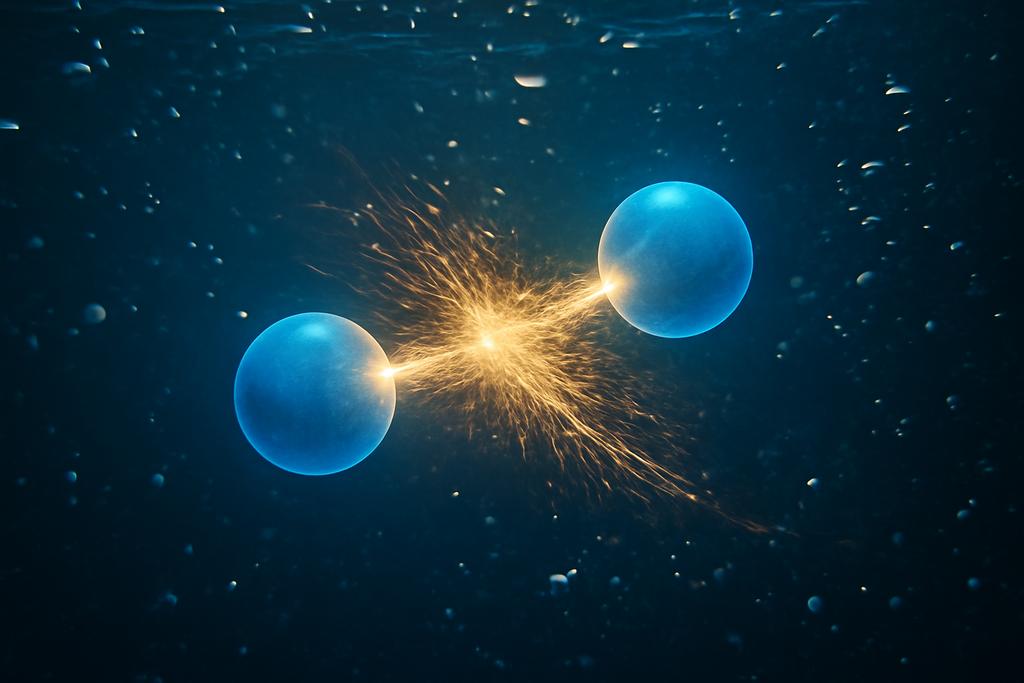Imagine the microscopic world, where atoms dance and electrons zip around. Now, picture a collision — not a car crash, but something far smaller, a fleeting interaction between two electrons, one ejected from an atom, the other kicked out in its wake. This is post-collision interaction (PCI), a phenomenon studied for decades in the vacuum of a laboratory, and now, surprisingly, being revealed in the busy, watery environment of everyday life.
The Unexpected Dance in Water
Researchers at Sorbonne Université and Synchrotron SOLEIL, led by Rémi Dupuy and Denis Céolin, have dove deep into this hidden microscopic dance. They’ve meticulously explored PCI not in the pristine isolation of a vacuum chamber, but within the bustling molecular crowd of liquid water, methanol, and ethanol. Their findings overturn our understanding of how these fundamental interactions behave outside the controlled conditions of a lab.
Traditionally, PCI was understood as a relatively simple interplay: a fast electron overtakes a slower one after they’ve both been ejected from an atom, trading energy in the process. This exchange alters their paths and energies, leaving a characteristic signature in experimental data. But add the complexity of a liquid environment, and suddenly the familiar rules seem to bend. The liquid acts as a sort of cosmic dance floor, with molecules influencing the choreography of these electron interactions.
The Double Whammy: Screening and Scattering
Two major effects emerge in the liquid phase: screening and scattering. Screening is like a wall of water molecules dampening the electric field between the two electrons, lessening their interaction strength. It’s analogous to trying to shout across a crowded room — your voice is muffled. In contrast, scattering is like a jostling crowd, constantly deflecting the electrons’ paths, making their trajectory erratic. It’s as if the two electrons are now navigating a chaotic maze, their interaction length affected by random encounters.
The researchers brilliantly used a combination of experiments and computer simulations to unravel these effects. Experiments at the GALAXIES beamline at the SOLEIL synchrotron provided the empirical data—the electron fingerprints of PCI within the different liquids. Then, sophisticated Monte Carlo simulations came into play to mimic the electrons’ chaotic dance. These simulations are like virtual reality for atomic physics, allowing researchers to explore electron movements within the liquids.
Unexpected Agreement: The Role of Simulations
The study revealed an unexpected level of agreement between the experimental data and the Monte Carlo simulations. The simulations, by incorporating electron scattering, captured the essence of PCI in the liquids more accurately than previous theoretical models. This highlights the crucial role of electron scattering in liquid-phase PCI — a factor that earlier models had largely overlooked. The findings demonstrate that the combined effect of electron scattering and screening modifies PCI in liquids, leading to measurable differences from gas-phase observations.
Beyond the Dance Floor: Implications and Future Directions
This study has broader implications that extend beyond atomic physics. Understanding PCI in liquids is vital for various scientific domains. For instance, it’s essential for interpreting data from X-ray photoelectron spectroscopy (XPS), a technique used to analyze the surface composition of materials. The presence of PCI can affect the accuracy of measurements, but the current research provides a new framework for taking it into account. This opens the door for improved accuracy in this widely used technique.
Moreover, the findings hold great promise for refining our knowledge of electron transport in liquids. The authors suggest that PCI experiments, analyzed with improved theoretical models, can be used as a new constraint to define the elusive scattering parameters in water, essential for other applications, including radiation biology and chemistry. In essence, the chaotic dance of electrons in water reveals not only fundamental physics but also provides a tool for advancing other fields.
This research is a testament to the power of interdisciplinary collaboration and the unexpected insights that emerge from exploring the seemingly mundane. The seemingly simple interaction of two electrons in water offers a powerful new lens through which to refine our understanding of electron transport in liquids and interpret existing data from widely-used experimental techniques. It’s a reminder that even within seemingly well-trodden areas of science, profound discoveries are still waiting to be unearthed.










